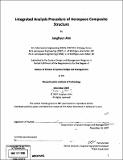Integrated analysis procedure of aerospace composite structure
Author(s)
Ahn, Junghyun
DownloadFull printable version (25.13Mb)
Other Contributors
System Design and Management Program.
Advisor
Patrick Hale.
Terms of use
Metadata
Show full item recordAbstract
The emergence of composite material application in major commercial aircraft design, represented by the Boeing 787 and Airbus A350-XWB, signals a new era in the aerospace industry. The high stiffness to weight ratio of continuous fiber composites (CFC) makes CFCs one of the most important materials to be introduced in modern aircraft industry. In addition to inherent strength (per given weight) of CFCs, they also offer the unusual opportunity to design the structure and material concurrently. The directional properties (and the ability to change these properties through the design process) of composite materials can be used in aeroelastically tailored wings, the fuselage and other critical areas. Due to the longer lifecycle (25-30 years) of a commercial airliner and the tools and processes developed for the airplane of previous product development cycles, new technology often ends up being deployed less effectively because of the mismatch in the technical potential (what can be done) vs. design tools and processes (what was done before). Tools and processes need to be current to take advantage of latest technology, and this thesis will describe one possible approach in primary composite structural design area using integrated structural analysis
Description
Thesis (S.M.)--Massachusetts Institute of Technology, System Design and Management Program, 2008. Includes bibliographical references (p. 50).
Date issued
2008Department
System Design and Management Program.Publisher
Massachusetts Institute of Technology
Keywords
System Design and Management Program.